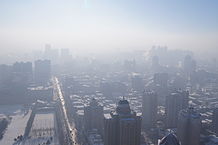Pictures of mask-wearing people walking the streets of smog-covered Asian cities have brought the health risks of air pollution into stark focus in recent years. Air pollution exposure has a marked effect on public health, contributing to 3.2 million premature deaths in 2010 alone, according to the Global Burden of Disease (GBD) study. Two-thirds of those deaths occurred in China, India, and other rapidly developing countries of Asia.
The Health Effects Institute (HEI) has initiated the Global Burden of Disease Major Air Pollution Sources (GBD MAPS) project, which will focus on the burden of disease attributed to air pollution, specifically that caused by coal burning in China, India and Eastern Europe. UBC’s Dr. Michael Brauer will co-chair the working group designing and conducting this project.
“We know that air pollution is a huge contributor to the global disease burden and now we are looking at specific sources,” said Dr. Brauer, a professor in the School of Population and Public Health. “We will look at coal burning, whether it be for industry, energy production or, to a lesser extent, home cooking and heating in rural areas, to quantify the health impacts of this source of air pollution to better inform energy and climate change policy.”
Using the GBD framework, the team will prepare a series of reports based on future emissions scenarios and disease and mortality projections.
“In China, for example, we will be looking at the effects of coal burning continuing to follow current trends, if it is reduced by x amount or if there are very aggressive reduction policies,” Brauer explained. “Fortunately, these are actually things that the Chinese government is already contemplating as they gear up for their country’s next Five Year Plan.”
In terms of health, the team will focus on those diseases already defined as GBD air pollution risks – ischemic heart disease, lung cancer, stroke, chronic obstructive pulmonary disease (COPD), and acute respiratory infections in children. “Our research is intended to provide more information so that evidence based policy can be developed,” said Brauer.
The three-year project will be undertaken sequentially, starting with China, then India and finally Eastern Europe.
In addition to HEI and UBC, the collaboration includes researchers from the Institute of Health Metrics and Evaluation (IHME) at the University of Washington, Tsinghua University in Beijing, Dalhousie University and other academic centres. The project itself is being undertaken with support from the William and Flora Hewlett Foundation and the Oak Foundation.


